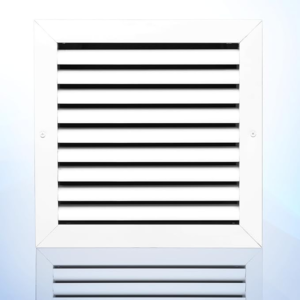Look up in any room with a heating, ventilation, and air conditioning (HVAC) system, and you’ll likely see a ceiling grille. These seemingly simple components play a vital role in distributing conditioned air throughout your space. This comprehensive guide dives into the world of ceiling grilles, exploring their purpose, types, functions, and even offers tips for selecting and maintaining them.

Understanding the Purpose of Ceiling Grilles:
Ceiling grilles are more than just decorative covers for vents in your ceiling. They are essential parts of your HVAC system, performing several key functions:
- Air Distribution: Ceiling grilles allow conditioned air (heated or cooled) from the ductwork to flow out into the room. The design of the grille and its positioning in the ceiling influence how the air is dispersed, ensuring even temperature distribution throughout the space.
- Directional Control: Some ceiling grilles have adjustable louvers or vanes. These allow you to direct the airflow to specific areas of the room, optimizing comfort and potentially improving efficiency. This is particularly helpful in rooms with unconventional layouts or furniture placement.
- Aesthetics: Ceiling grilles come in various styles and materials. They can blend seamlessly with your existing décor or add a touch of elegance to a room.
- Safety: Ceiling grilles prevent larger objects from accidentally entering the ductwork, which could damage the system or pose a fire hazard.
Types of Ceiling Grilles:
There are various types of ceiling grilles available, each with its own advantages and applications:
- Fixed Grilles: These are the most common type. They offer a simple design with a fixed pattern of openings, allowing for airflow but without any directional control.
- Adjustable Louvered Grilles: These grilles have adjustable louvers or vanes that can be opened, closed, or angled to direct airflow in a specific direction. This allows for better temperature control in different zones of a room.
- Return Air Grilles: While most ceiling grilles supply conditioned air, return air grilles are positioned at the other end of the airflow circulation loop. They allow return air to be drawn back into the HVAC system for filtering and re-conditioning.
- Diffuser Grilles: These specialized grilles are designed to disperse air more evenly throughout a room. They often have intricate patterns or vanes that help to mix and diffuse the air for optimal comfort and temperature control.
- Ceiling Registers: While sometimes used interchangeably, registers are a specific type of adjustable grille typically found on walls or floors. They often have dampers that can completely shut off airflow in addition to directional control.
Choosing the Right Ceiling Grille:
Selecting the appropriate ceiling grille depends on several factors:
- Function: Consider whether you need a simple fixed grille or one with adjustable louvers for directional control.
- Size: The size of the grille should match the size of the duct opening in your ceiling.
- Material: Ceiling grilles come in various materials like metal, plastic, or wood. Metal grilles are generally more durable, while plastic ones might be more budget-friendly. Wood grilles can add a decorative touch but require more maintenance.
- Aesthetics: Choose a grille style that complements your existing décor.
Installation and Maintenance Tips:
- Professional Installation: For optimal performance, it’s recommended to have a qualified HVAC professional install your ceiling grilles.
- Cleaning: Clean your ceiling grilles regularly to remove dust and debris buildup that can obstruct airflow and reduce efficiency. Use a vacuum cleaner with a soft brush attachment or a damp cloth. Avoid using harsh chemicals or abrasive cleaners.
- Painting: If you plan to paint your ceiling grilles, ensure proper ventilation and choose a paint specifically designed for metal or plastic surfaces.
Beyond the Basics: Advanced Ceiling Grille Features:
Some advanced ceiling grilles offer additional features:
- Noise Reduction: Certain grilles incorporate sound-dampening materials to reduce noise associated with airflow.
- Humidity Control: Special grilles might be designed to help regulate humidity levels within a room.
- Smart Controls: Emerging technologies might integrate smart controls into ceiling grilles, allowing for remote adjustments or integration with smart home systems.
Conclusion:
Ceiling grilles are much more than just vent covers. They play a vital role in ensuring efficient and comfortable air distribution within your home’s HVAC system. By understanding their types, functions, and selection factors, you can choose the right ceiling grilles to optimize your comfort and potentially improve the efficiency of your HVAC system. Remember, proper maintenance and occasional cleaning go a long way in ensuring their optimal performance for years to come.
Looking to install a commercial HVAC System or Duct work in your Business Area?
Contact Vipul Ac to learn about our HVAC Service
Call +91 9825636606 Today.
